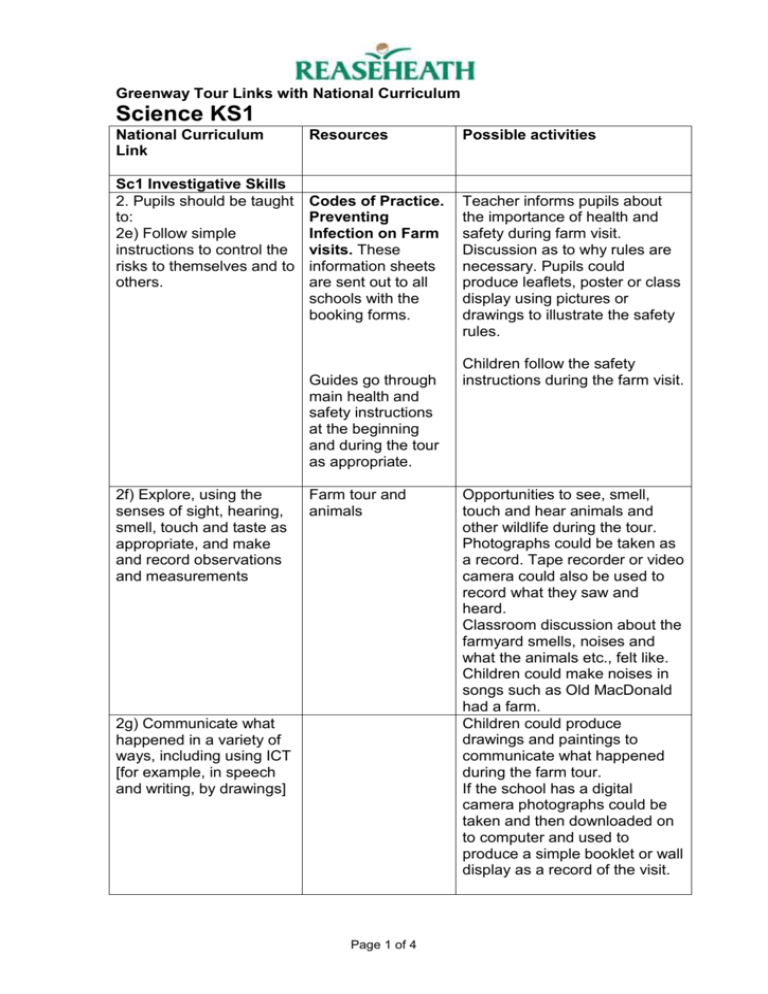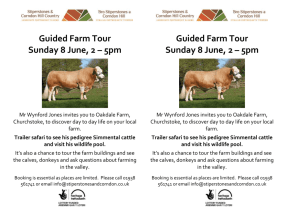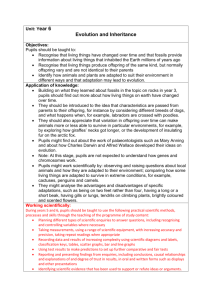Key Stage 1 Lesson Plan
advertisement

Greenway Tour Links with National Curriculum Science KS1 National Curriculum Link Sc1 Investigative Skills 2. Pupils should be taught to: 2e) Follow simple instructions to control the risks to themselves and to others. Resources Possible activities Codes of Practice. Preventing Infection on Farm visits. These information sheets are sent out to all schools with the booking forms. Teacher informs pupils about the importance of health and safety during farm visit. Discussion as to why rules are necessary. Pupils could produce leaflets, poster or class display using pictures or drawings to illustrate the safety rules. Guides go through main health and safety instructions at the beginning and during the tour as appropriate. 2f) Explore, using the senses of sight, hearing, smell, touch and taste as appropriate, and make and record observations and measurements Farm tour and animals 2g) Communicate what happened in a variety of ways, including using ICT [for example, in speech and writing, by drawings] Page 1 of 4 Children follow the safety instructions during the farm visit. Opportunities to see, smell, touch and hear animals and other wildlife during the tour. Photographs could be taken as a record. Tape recorder or video camera could also be used to record what they saw and heard. Classroom discussion about the farmyard smells, noises and what the animals etc., felt like. Children could make noises in songs such as Old MacDonald had a farm. Children could produce drawings and paintings to communicate what happened during the farm tour. If the school has a digital camera photographs could be taken and then downloaded on to computer and used to produce a simple booklet or wall display as a record of the visit. Sc2 Life processes and living things Life processes b) That animals, including humans, move, feed, grow, use their senses and reproduce c) To relate life processes to animals and plants found in the local environment. Where’s my mummy? Worksheet Adult animals and their offspring observed during the tour. There will generally be a range of offspring at different stages of development. Information sheets entitled Sheep, cows and pigs at Reaseheath College Animals feeding and moving. This worksheet enables children to match pictures of young animals to adults Observation of adult animals and their offspring makes children aware that animals produce offspring. The range of offspring at different stages of development will help children realise that baby animals grow. These sheets provide pictures and information that teachers could use about baby animals, how they grow and feed. Animals feeding and moving will be observed by the children during the tour. A selection of these questions could be used by the teacher as a verbal quiz in the classroom. Farm animal question sheets Animal body parts Children complete body parts Humans and other pictures – cow and worksheets so that they can animals recognise and name external 2.Pupils should be taught: hen body parts on different animals. a) To recognise and Children could be asked to compare the main compare these parts with the external parts of the human body and say how they bodies of humans and differ. other animals b) That humans and other Animals eating and drinking during the animals need food and tour water to stay alive Information sheets entitled Sheep, cows and pigs at Reaseheath College Farm animal question sheets Page 2 of 4 The children will observe animals feeding and drinking during the tour. The information sheets provide detail of what the animals eat at different times of the year. This again could be used as a simple quiz. e) How to treat animals with care and sensitivity Codes of practice Instructions from guides. f) That humans and other animals can produce offspring and that these offspring grow into adults Where’s my mummy? Worksheet Adult animals and their offspring observed during the tour. There will generally be a range of offspring at different stages of development. Information sheets entitled Sheep, cows and pigs at Reaseheath College g) About the senses that enable humans and other animals to be aware of the world around them. Variation and classification 4. Pupils should be taught to: b) Group living things according to observable similarities and differences. b) Identify similarities and differences between local environments and ways in which these affect animals and plants that are found there Farm animal question sheets Farm animal reactions The noises that the animals make to communicate with each other. Pupils could do a simple roleplay showing how treat animals with care and sensitivity. This worksheet enables children to match pictures of young animals to adults Observation of adult animals and their offspring makes children aware that animals produce offspring. The range of offspring at different stages of development will help children realise that baby animals grow. These sheets provide pictures and information that teachers could use about baby animals, how they grow and feed. A selection of these questions could be used by the teacher as a verbal quiz in the classroom. Children observe animals and comment on how the animals react to them. How the animal’s ears prick up to show that they are listening, they may back away and stare at them. Later the animals may come over to the children and sniff and lick them using. This shows how the animals use all their senses to find out more about the children. Is it an animal or is Complete table by drawing or it a bird?Table. placing pictures of animals in the appropriate columns Different environments Large wall displays could be visited during the produced showing lake, tour e.g., the lake, woodland and a farm. Children wooded area, and could then produce pictures of farm. Wide range of the different plants and animals animals and plants they observed during the tour. can be observed These pictures can then be during the placed on the appropriate Greenway section of the wall display. Page 3 of 4 c) Care for the environment. experience. This will vary depending on the time of year. Children colour in and go over Simple word and the word for the animal. This animal pictures. helps them recognise and be able to name some common animals found in their local environments. Codes of Practice Children could produce posters or leaflets to make people more aware of caring for the environment. Page 4 of 4







